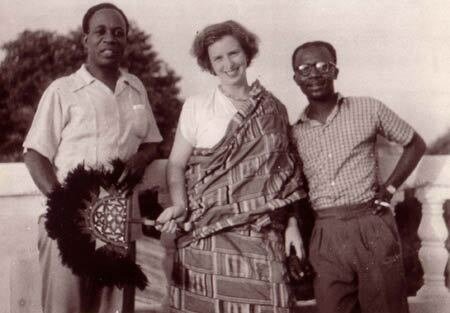Enid Margaret Cripps (Peggy Appiah), the Well-Known British-Ghanaian Writer of Books for Children and Wife of the Late Ghanaian Statesman Joe Appiah

Margaret Cripps was born on 21 May 1921. she was the fourth child of the Right Honourable Sir Stafford Cripps and Dame Isobel Cripps.
Peggy Cripps was born in Goodfellows Gloucestershire, just across the county
border from the home of her parents, Stafford Cripps and Isobel (née) Swithinbank, in the village of Filkins, Oxfordshire.
The family had only recently moved into Goodfellows, the home in Filkins where Peggy
grew up; a Cotswold-style manor house, whose decoration and development owed much to
the influence of Sir Lawrence Weaver, the architect, who was, with his wife Kathleen, one of the Cripps’ closest friends.
Marriage
Peggy Cripps caused an international sensation when she announced plans to marry in July 1953.

Her fiancé was Joe Appiah, who was in London as a law student and representative of Kwame Nkrumah, prime minister of the Gold Coast.
Her marriage to Joe Appiah was one of the most sensational romantic expressions between
a black and a white and was a puzzle in the British media at the time.
The marriage came to symbolize far more than the union of two individuals.
And it became an international story with resonance because it involved the daughter of a former chancellor.

After her marriage in 1953, she moved together with her husband to Ghana and Settled in Kumasi, the capital of Ashanti, Peggy Appiah eventually had four children.
Making her home in Ghana since 1954, Peggy Appiah spent over 50 years in Kumasi since she left England after her marriage to the Ghanaian lawyer Joe Appiah.
For all these years, she chronicled both as a profession and hobby, traditional folklore of
the Asante people–village lives as well as natural history.
During these years Peggy Appiah learned to wear the local cloth on ceremonial occasions and learned the language of the Asante, Twi.

Works
Deeply knowledgeable about Ashanti culture, she decided to start writing so that native
children could have access to a literature of their own.
“The wind in the willows is the same one that breathes through the palm fronds,” she wrote.
She argued for the “universality of children’s lore”.
An early successful book was Ananse the Spider: tales from an Ashanti village (1966).
This mischievous spider-god, whose adventures often resembled those found in both Aesop
and Brer Rabbit, was to re-appear in The Children of Ananse (1968).
Other stories concentrated more on African rustic and forest life, in particular A Smell of
Onions (1971), a tangled tale of village life originally intended for adults.
There were also shorter books with African backgrounds written in simple English for use mainly in schools.
Some of these concentrated on her great love of animals and birds.
Others like Busy Body (1995) and The Rubbish Heap (1995) took on more urban themes.
She also wrote Bu Me Bé: Akan proverbs (2003) on which she collaborated with her son.
Peggy Appiah continued writing, producing Thought Birds (2001), a short book of poems, to celebrate her 80th birthday.

Death
Joe Appiah died in Accra after an illness and was buried at the Tafo cemetery at Kumasi in the Ashanti Region of Ghana July 8, 1990.
After her husband’s demise, people asked her, ‘When are you going home?’ She kept saying, ‘I am home.’
Peggy Cripps bought a plot at Tafo cemetery in Kumasi, so that when she died, she would
not be sent back to England, but be buried next to her husband, who died in 1990.
Peggy Appiah died in February 11, 2006 at age 84